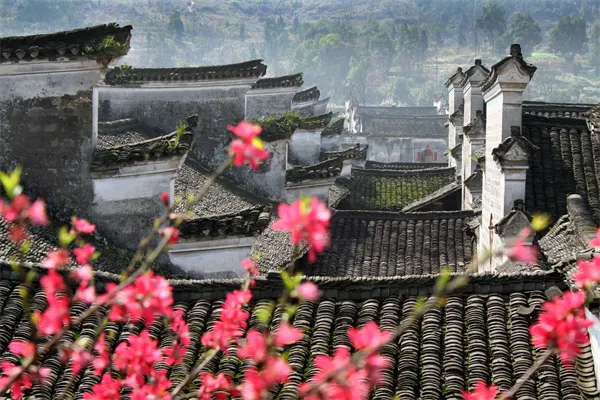Hunan has three new national boutique rural tourism routes
2024-08-02
Tour of ancient buildings in Lingling District, Yongzhou City
Zhou’s Family Compound is the largest and most functional ancient residential complex in Southern Hunan. Descendants of Zhou Dunyi, the founder of Neo-Confucianism in the Song Dynasty, settled down here. Here, tourists can learn about Chinese agricultural culture, ancient buildings in Ming and Qing dynasties, and family styles of Zhou Dunyi.

Then, tourists can go to visit Pingzhou Academy, and take a boat from the ancient city pier to enjoy the scenery along the Xiaoshui River. They will also have a close look at the Huilong Pagoda, a national key cultural relic protection unit, appreciate Xiaoxiang night rain, the first of the eight Xiaoxiang views, and experience academy culture.

After getting off the boat, tourists can walk to Liuzi Street to try on ancient costumes, experience the slow life of the old street, pay respects to Liu Zongyuan at Liuzi Temple, and learn about Liu’s culture.

Walking from Liu Zongyuan Cultural Tourism Area to the western gate pier, tourists can take a boat to Chaoyang Rock and Xiangling Mountain successively, two of the “eight views of Yongzhou”.

After visiting Xiangling Mountain, tourists can also experience the fun of picking fruits and vegetables at Xianglinshan Village, a five-star rural attraction.
Tourists can walk from the western gate pier to Dongshan Mountain Scenic Area via the Xiaoshui Historical and Cultural Block in 15 minutes to take photos at old streets and alleys.

Tourists can walk or take a car from Dongshan Mountain to Lingling Ancient Town to watch folk performances, taste delectable snacks, purchase local specialties, go to the public house for a drink, and then directly stay at the homestay inns or hotels in the ancient town.

Itinerary: Zhou’s Family Compound, Pingzhou Academy, Liu Zongyuan Cultural Tourism Area, Lingling Ancient Town, Chaoyang Rock, Xiangling Mountain, Dongshan Mountain
Tour of millennium-old porcelain capital in Liling City, Zhuzhou City
Liling has profound culture and flourishing industries. In Liling, tourists can experience pastoral life, immerse themselves in the bustle and hustle of urban areas, and soak up culture in ancient buildings.
Visitors can spend a weekend to learn about the history of porcelain making in Liling which originated from the Eastern Han Dynasty, developed in the Tang and Song Dynasties, and got prosperous in the Ming and Qing Dynasties. At the same time, they can also pick up porcelain, shoot off fireworks, eat fried dishes and watch dramas.
Itinerary: China Ceramic Valley, Liling Kiln, Geng’s Ancestral Temple, Fengxi Valley, Yuyuan cultural tourist attraction, Lujiang Academy, Porcelain City
Liling Kiln Site consists of a group of large-scale ancient porcelain kiln sites, with a total concentrated distribution area of 129 square kilometers. It witnesses the history of porcelain firing in Liling from the Eastern Han Dynasty. It is the birthplace of Liling’s porcelain industry, including the under-glaze multicolored porcelain, and a “living encyclopedia” for studying the development history of Chinese ceramics.

Located in the core area of Yuexingwan ancient kiln factory of Weishan kiln area, it is one of the completely preserved ancient kiln sites in China. The mud preparing workshops, mud precipitation ponds, porcelain-making workshops, kilns, warehouses, etc. are well-preserved, presenting the traditional porcelain making process of Liling Kiln.
Huangxiang Residence, also known as Geng’s Ancestral Temple, located in Longxing’ao Village of Liling City, was built in 1861. It adopts the typical courtyard layout in East Hunan, and integrates the cultural concept of architecture in the Ming and Qing dynasties in the south. It is a typical and influential ancient building in late Qing Dynasty in Liling and even in Eastern Hunan at that time, and also a part of the Red tourism and farming culture exhibition area in Liling City.

Lujiang Academy is one of the eight academies in Liling with a large scale, long running time and far-reaching influence, and it is well-preserved.
Zhu Xi, and Wang Shouren once lectured here, Zuo Zongtang once served as a head of the academy, and Li Lisan, Zuo Quan, etc. studied here. Around the academy, there are such attractions as Xixin Spring, Jingxing Temple and Ning Taiyi’s Tomb.

Tour of ancient buildings in Yueyang City
This route allows tourists to appreciate the unique charm of ancient architectural complexes such as Yueyang Tower, Confucian Temple, and Zhangguying Village.
Itinerary: Yueyang Tower Tourist Area, Zhangguying Village of Yueyang County, Quzi Temple, Changle Ancient Town
Zhangguying Ancient Architecture Complex is a national key cultural relic protection unit, located in Zhangguying Town, Yueyang County, 70 kilometers away from Yueyang City.

Since Zhang Guying moved to this place in the early Ming Dynasty, his descendants have multiplied and lived here for more than 600 years. It is a relatively well preserved traditional Chinese village to this day.
The ancient village integrates the Chinese traditional culture, architectural art, and aesthetic taste, and is of great research value in the history of architecture.
Quzi Temple is a national key cultural relic protection unit, located on Yusi Mountain on the north bank of the lower reaches of the Miluo River in Miluo City.

It was built in memory of the great patriotic poet Qu Yuan. It was first built in the Han Dynasty and has been repaired for many times.
Today’s Quzi Temple was moved here in 1754, the 19th year of Emperor Qianlong’s reign in the Qing Dynasty. The existing building is of a wood structure, with Duxing Pavilion and Lisao Platform around.


